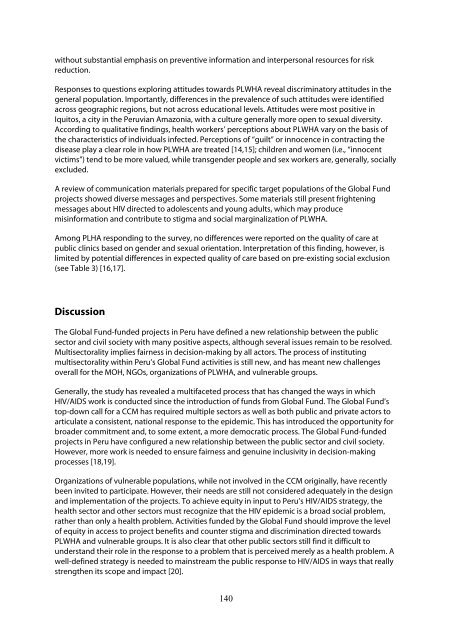MAXIMIZING POSITIVE SYNERGIES - World Health Organization
MAXIMIZING POSITIVE SYNERGIES - World Health Organization
MAXIMIZING POSITIVE SYNERGIES - World Health Organization
You also want an ePaper? Increase the reach of your titles
YUMPU automatically turns print PDFs into web optimized ePapers that Google loves.
without substantial emphasis on preventive information and interpersonal resources for risk<br />
reduction.<br />
Responses to questions exploring attitudes towards PLWHA reveal discriminatory attitudes in the<br />
general population. Importantly, differences in the prevalence of such attitudes were identified<br />
across geographic regions, but not across educational levels. Attitudes were most positive in<br />
Iquitos, a city in the Peruvian Amazonia, with a culture generally more open to sexual diversity.<br />
According to qualitative findings, health workers’ perceptions about PLWHA vary on the basis of<br />
the characteristics of individuals infected. Perceptions of “guilt” or innocence in contracting the<br />
disease play a clear role in how PLWHA are treated [14,15]; children and women (i.e., “innocent<br />
victims”) tend to be more valued, while transgender people and sex workers are, generally, socially<br />
excluded.<br />
A review of communication materials prepared for specific target populations of the Global Fund<br />
projects showed diverse messages and perspectives. Some materials still present frightening<br />
messages about HIV directed to adolescents and young adults, which may produce<br />
misinformation and contribute to stigma and social marginalization of PLWHA.<br />
Among PLHA responding to the survey, no differences were reported on the quality of care at<br />
public clinics based on gender and sexual orientation. Interpretation of this finding, however, is<br />
limited by potential differences in expected quality of care based on pre-existing social exclusion<br />
(see Table 3) [16,17].<br />
Discussion<br />
The Global Fund-funded projects in Peru have defined a new relationship between the public<br />
sector and civil society with many positive aspects, although several issues remain to be resolved.<br />
Multisectorality implies fairness in decision-making by all actors. The process of instituting<br />
multisectorality within Peru’s Global Fund activities is still new, and has meant new challenges<br />
overall for the MOH, NGOs, organizations of PLWHA, and vulnerable groups.<br />
Generally, the study has revealed a multifaceted process that has changed the ways in which<br />
HIV/AIDS work is conducted since the introduction of funds from Global Fund. The Global Fund’s<br />
top-down call for a CCM has required multiple sectors as well as both public and private actors to<br />
articulate a consistent, national response to the epidemic. This has introduced the opportunity for<br />
broader commitment and, to some extent, a more democratic process. The Global Fund-funded<br />
projects in Peru have configured a new relationship between the public sector and civil society.<br />
However, more work is needed to ensure fairness and genuine inclusivity in decision-making<br />
processes [18,19].<br />
<strong>Organization</strong>s of vulnerable populations, while not involved in the CCM originally, have recently<br />
been invited to participate. However, their needs are still not considered adequately in the design<br />
and implementation of the projects. To achieve equity in input to Peru’s HIV/AIDS strategy, the<br />
health sector and other sectors must recognize that the HIV epidemic is a broad social problem,<br />
rather than only a health problem. Activities funded by the Global Fund should improve the level<br />
of equity in access to project benefits and counter stigma and discrimination directed towards<br />
PLWHA and vulnerable groups. It is also clear that other public sectors still find it difficult to<br />
understand their role in the response to a problem that is perceived merely as a health problem. A<br />
well-defined strategy is needed to mainstream the public response to HIV/AIDS in ways that really<br />
strengthen its scope and impact [20].<br />
140

















